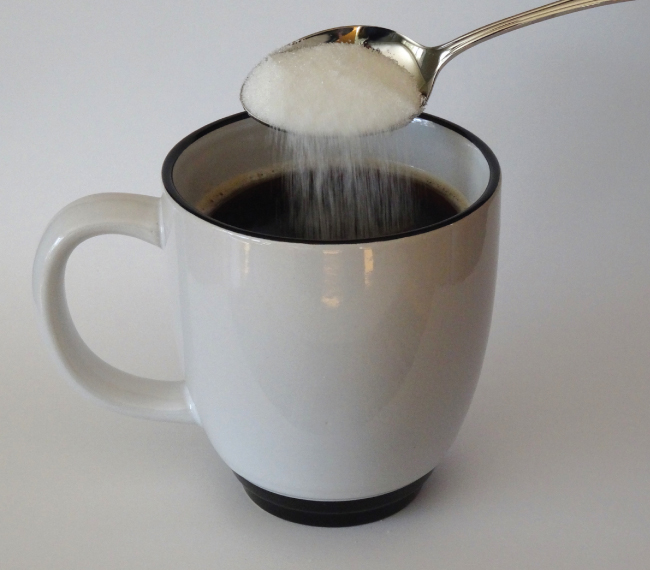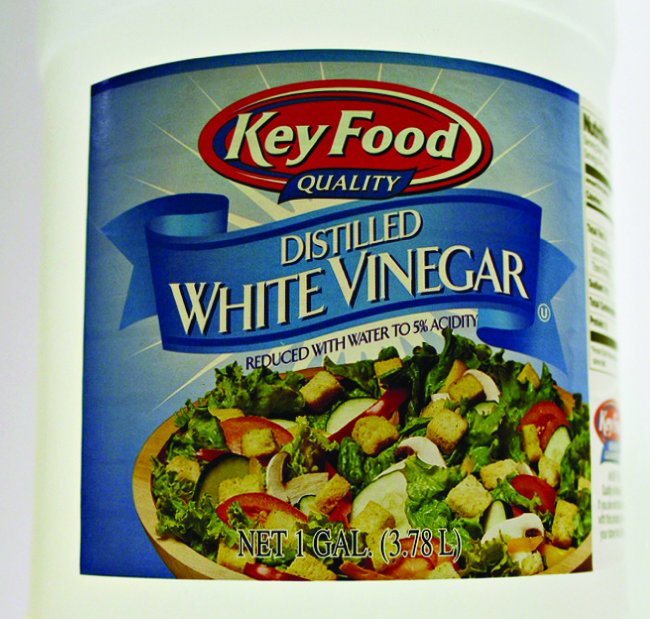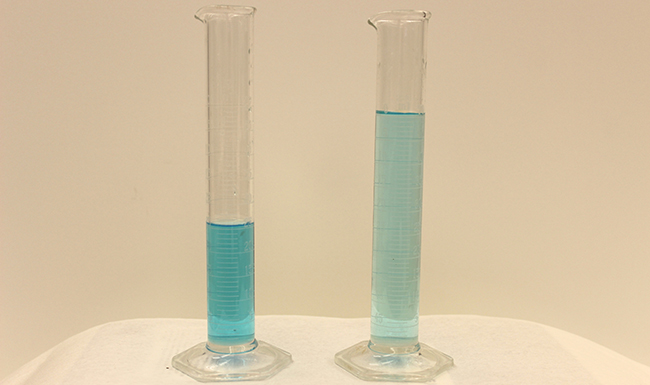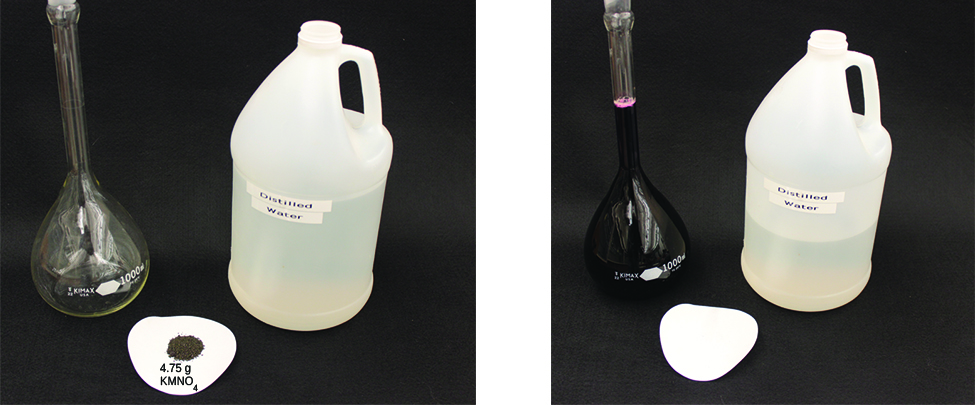what volume of a 10.00% (w/v) solution of sugar is needed to provide 2.00 g of sugar?
Chapter 3. Composition of Substances and Solutions
three.3 Molarity
Learning Objectives
By the terminate of this section, yous will be able to:
- Describe the fundamental backdrop of solutions
- Calculate solution concentrations using molarity
- Perform dilution calculations using the dilution equation
In preceding sections, nosotros focused on the composition of substances: samples of thing that contain but one blazon of element or compound. Even so, mixtures—samples of matter containing two or more substances physically combined—are more commonly encountered in nature than are pure substances. Similar to a pure substance, the relative composition of a mixture plays an important role in determining its properties. The relative amount of oxygen in a planet's atmosphere determines its ability to sustain aerobic life. The relative amounts of iron, carbon, nickel, and other elements in steel (a mixture known equally an "alloy") determine its physical strength and resistance to corrosion. The relative amount of the active ingredient in a medicine determines its effectiveness in achieving the desired pharmacological effect. The relative corporeality of carbohydrate in a potable determines its sweetness (see Figure 1). In this section, we will depict one of the most common ways in which the relative compositions of mixtures may be quantified.

Solutions
We take previously defined solutions as homogeneous mixtures, meaning that the limerick of the mixture (and therefore its properties) is uniform throughout its entire volume. Solutions occur frequently in nature and take also been implemented in many forms of manmade engineering science. We will explore a more than thorough handling of solution properties in the chapter on solutions and colloids, but here we will introduce some of the basic properties of solutions.
The relative corporeality of a given solution component is known as its concentration. Ofttimes, though not ever, a solution contains one component with a concentration that is significantly greater than that of all other components. This component is called the solvent and may be viewed as the medium in which the other components are dispersed, or dissolved. Solutions in which h2o is the solvent are, of course, very mutual on our planet. A solution in which water is the solvent is called an aqueous solution.
A solute is a component of a solution that is typically present at a much lower concentration than the solvent. Solute concentrations are frequently described with qualitative terms such as dilute (of relatively low concentration) and concentrated (of relatively high concentration).
Concentrations may be quantitatively assessed using a wide diversity of measurement units, each convenient for item applications. Molarity (M) is a useful concentration unit for many applications in chemistry. Molarity is defined as the number of moles of solute in exactly 1 liter (1 L) of the solution:
[latex]Chiliad = \frac{\text{mol solute}}{\text{50 solution}}[/latex]
Case 1
Calculating Molar Concentrations
A 355-mL soft drink sample contains 0.133 mol of sucrose (tabular array saccharide). What is the molar concentration of sucrose in the beverage?
Solution
Since the molar amount of solute and the volume of solution are both given, the molarity tin exist calculated using the definition of molarity. Per this definition, the solution volume must exist converted from mL to 50:
[latex]M = \frac{\text{mol solute}}{\text{L solution}} = \frac{0.133 \;\text{mol}}{355 \;\text{mL} \times \frac{1 \;\text{L}}{1000 \;\text{mL}}} = 0.375 \; M[/latex]
Check Your Learning
A teaspoon of tabular array sugar contains about 0.01 mol sucrose. What is the molarity of sucrose if a teaspoon of carbohydrate has been dissolved in a cup of tea with a volume of 200 mL?
Case 2
Deriving Moles and Volumes from Molar Concentrations
How much carbohydrate (mol) is contained in a pocket-sized sip (~10 mL) of the soft drink from Instance ane?
Solution
In this case, we can rearrange the definition of molarity to isolate the quantity sought, moles of sugar. We then substitute the value for molarity that we derived in Example i, 0.375 1000:
[latex]M = \frac{\text{mol solute}}{\text{Fifty solution}}[/latex]
[latex]\text{mol solute} = K \times \text{Fifty solution}[/latex]
[latex]\text{mol solute} = 0.375 \;\frac{\text{mol carbohydrate}}{\text{L}} \times (10 \;\text{mL} \times \frac{1 \text{L}}{yard \;\text{mL}}) = 0.004 \;\text{mol saccharide}[/latex]
Check Your Learning
What volume (mL) of the sweetened tea described in Case 1 contains the aforementioned amount of carbohydrate (mol) equally ten mL of the soft drink in this example?
Example 3
Computing Tooth Concentrations from the Mass of Solute
Distilled white vinegar (Figure 2) is a solution of acetic acid, CHiiiCO2H, in water. A 0.500-L vinegar solution contains 25.two thousand of acetic acid. What is the concentration of the acetic acid solution in units of molarity?

Solution
As in previous textbox shaded, the definition of molarity is the primary equation used to calculate the quantity sought. In this case, the mass of solute is provided instead of its molar amount, and so we must use the solute's tooth mass to obtain the corporeality of solute in moles:
[latex]M = \frac{\text{mol solute}}{\text{Fifty solution}} = \frac{25.2 \;\text{g CH}_3\text{CO}_2\text{H} \times \frac{one \;\text{mol CH}_2\text{CO}_2\text{H}}{60.052 \;\text{m CH}_2\text{CO}_2\text{H}}}{0.500 \;\text{L solution}} = 0.839 \;Thou[/latex]
[latex]\brainstorm{array}{r @{{}={}} l} Grand & \frac{\text{mol solute}}{\text{50 solution}} = 0.839\;M \\[1em] M & \frac{0.839 \;\text{mol solute}}{i.00 \;\text{L solution}} \end{array}[/latex]
Check Your Learning
Calculate the molarity of 6.52 thousand of CoCl2 (128.9 g/mol) dissolved in an aqueous solution with a total volume of 75.0 mL.
Case 4
Determining the Mass of Solute in a Given Volume of Solution
How many grams of NaCl are contained in 0.250 L of a 5.xxx-M solution?
Solution
The volume and molarity of the solution are specified, and then the amount (mol) of solute is easily computed every bit demonstrated in Example 2:
[latex]M = \;\frac{\text{mol solute}}{\text{L solution}}[/latex]
[latex]\text{mol solute} = One thousand \times \text{L solution}[/latex]
[latex]\text{mol solute} = 5.thirty \;\frac{\text{mol NaCl}}{\text{L}} \times 0.250 \;\text{50} = 1.325 \;\text{mol NaCl}[/latex]
Finally, this molar amount is used to derive the mass of NaCl:
[latex]1.325 \;\text{mol NaCl} \times \frac{58.44 \;\text{g NaCl}}{\text{mol NaCl}} = 77.4 \;\text{g NaCl}[/latex]
Check Your Learning
How many grams of CaClii (110.98 g/mol) are contained in 250.0 mL of a 0.200-K solution of calcium chloride?
When performing calculations stepwise, as in Example 4, information technology is of import to refrain from rounding any intermediate calculation results, which can lead to rounding errors in the final result. In Example 4, the molar corporeality of NaCl computed in the first step, 1.325 mol, would be properly rounded to 1.32 mol if it were to be reported; nevertheless, although the last digit (5) is not significant, it must be retained as a baby-sit digit in the intermediate calculation. If nosotros had not retained this baby-sit digit, the last calculation for the mass of NaCl would take been 77.1 g, a difference of 0.iii chiliad.
In addition to retaining a guard digit for intermediate calculations, we can too avoid rounding errors by performing computations in a single pace (run across Example 5). This eliminates intermediate steps and then that but the concluding result is rounded.
Instance v
Determining the Book of Solution Containing a Given Mass of Solute
In Example 3, we found the typical concentration of vinegar to be 0.839 M. What volume of vinegar contains 75.6 g of acetic acrid?
Solution
First, use the molar mass to calculate moles of acerb acrid from the given mass:
[latex]\text{k solute} \times \frac{\text{mol solute}}{\text{g solute}} = \text{mol solute}[/latex]
And so, use the molarity of the solution to summate the volume of solution containing this molar amount of solute:
[latex]\text{mol solute} \times \frac{\text{L solution}}{\text{mol solute}} = \text{L solution}[/latex]
Combining these two steps into one yields:
[latex]\text{g solute} \times \frac{\text{mol solute}}{\text{g solute}} \times \frac{\text{L solution}}{\text{mol solute}} = \text{L solution}[/latex][latex]75.6 \;\text{g CH}_3\text{CO}_2\text{H} (\frac{\text{mol CH}_3\text{CO}_2\text{H}}{60.05 \;\text{g}}) (\frac{\text{L solution}}{0.839 \;\text{mol CH}_3\text{CO}_2\text{H}}) = 1.50 \;\text{L solution}[/latex]
Bank check Your Learning
What volume of a 1.50-1000 KBr solution contains 66.0 g KBr?
Dilution of Solutions
Dilution is the process whereby the concentration of a solution is lessened by the add-on of solvent. For example, we might say that a drinking glass of iced tea becomes increasingly diluted every bit the ice melts. The water from the melting water ice increases the volume of the solvent (h2o) and the overall book of the solution (iced tea), thereby reducing the relative concentrations of the solutes that give the beverage its gustation (Effigy 3).

Dilution is also a common means of preparing solutions of a desired concentration. Past adding solvent to a measured portion of a more full-bodied stock solution, we can reach a particular concentration. For example, commercial pesticides are typically sold as solutions in which the active ingredients are far more concentrated than is advisable for their application. Earlier they tin can be used on crops, the pesticides must be diluted. This is also a very mutual practise for the preparation of a number of mutual laboratory reagents (Effigy 4).

A simple mathematical relationship tin can be used to relate the volumes and concentrations of a solution before and after the dilution procedure. According to the definition of molarity, the molar amount of solute in a solution is equal to the product of the solution'south molarity and its volume in liters:
[latex]north = ML[/latex]
Expressions like these may be written for a solution before and after it is diluted:
[latex]n_1 = M_1L_1[/latex]
[latex]n_2 = M_2L_2[/latex]
where the subscripts "1" and "2" refer to the solution before and after the dilution, respectively. Since the dilution process does not change the amount of solute in the solution, n 1 = due north ii. Thus, these two equations may be set up equal to i some other:
[latex]M_1L_1 = M_2L_2[/latex]
This relation is commonly referred to as the dilution equation. Although nosotros derived this equation using molarity as the unit of concentration and liters every bit the unit of book, other units of concentration and volume may be used, so long as the units properly cancel per the factor-label method. Reflecting this versatility, the dilution equation is frequently written in the more general class:
[latex]C_1V_1 = C_2V_2[/latex]
where C and 5 are concentration and volume, respectively.

Use the simulation to explore the relations between solute corporeality, solution volume, and concentration and to confirm the dilution equation.
Example six
Determining the Concentration of a Diluted Solution
If 0.850 L of a 5.00-M solution of copper nitrate, Cu(NO3)2, is diluted to a book of 1.80 L by the improver of water, what is the molarity of the diluted solution?
Solution
We are given the volume and concentration of a stock solution, V 1 and C 1, and the book of the resultant diluted solution, V 2. We need to find the concentration of the diluted solution, C 2. Nosotros thus rearrange the dilution equation in order to isolate C two:
[latex]C_1V_1 = C_2V_2[/latex]
[latex]C_2 = \frac{C_1V_1}{V_2}[/latex]
Since the stock solution is existence diluted by more than two-fold (book is increased from 0.85 L to ane.80 L), nosotros would expect the diluted solution's concentration to exist less than one-half 5 Thousand. We will compare this ballpark judge to the calculated issue to check for any gross errors in computation (for example, such equally an improper exchange of the given quantities). Substituting the given values for the terms on the right side of this equation yields:
[latex]C_2 = \frac{0.850 \;\text{L} \times five.00 \frac{\text{mol}}{\text{L}}}{1.eighty \;\text{L}} = 2.36 \;M[/latex]
This result compares well to our ballpark estimate (it's a bit less than one-one-half the stock concentration, 5 1000).
Cheque Your Learning
What is the concentration of the solution that results from diluting 25.0 mL of a 2.04-Yard solution of CHiiiOH to 500.0 mL?
Instance 7
Book of a Diluted Solution
What volume of 0.12 M HBr can be prepared from xi mL (0.011 50) of 0.45 Thousand HBr?
Solution
We are given the volume and concentration of a stock solution, Five ane and C 1, and the concentration of the resultant diluted solution, C 2. We need to find the volume of the diluted solution, V ii. We thus rearrange the dilution equation in club to isolate 5 2:
[latex]C_1V_1 = C_2V_2[/latex]
[latex]V_2 = \frac{C_1V_1}{C_2}[/latex]
Since the diluted concentration (0.12 M) is slightly more than than one-fourth the original concentration (0.45 M), we would look the volume of the diluted solution to be roughly iv times the original volume, or around 44 mL. Substituting the given values and solving for the unknown volume yields:
[latex]V_2 = \frac{(0.45\;M)(0.011 \;\text{50})}{0.12 \; Thousand}[/latex]
[latex]V_2 = 0.041 \;\text{L}[/latex]
The volume of the 0.12-Thousand solution is 0.041 L (41 mL). The result is reasonable and compares well with our rough estimate.
Bank check Your Learning
A laboratory experiment calls for 0.125 M HNO3. What volume of 0.125 Thou HNOiii tin be prepared from 0.250 L of 1.88 M HNO3?
Example 8
Volume of a Concentrated Solution Needed for Dilution
What book of one.59 M KOH is required to prepare v.00 50 of 0.100 G KOH?
Solution
We are given the concentration of a stock solution, C ane, and the volume and concentration of the resultant diluted solution, 5 2 and C 2. We need to find the book of the stock solution, Five ane. We thus rearrange the dilution equation in order to isolate Five 1:
[latex]C_1V_1 = C_2V_2[/latex]
[latex]V_2 = \frac{C_2V_2}{C_2}[/latex]
Since the concentration of the diluted solution 0.100 Thou is roughly one-sixteenth that of the stock solution (1.59 M), nosotros would expect the volume of the stock solution to be about i-sixteenth that of the diluted solution, or effectually 0.3 liters. Substituting the given values and solving for the unknown volume yields:
[latex]V_1 = \frac{(0.100\;K)(v.00 \;\text{L})}{1.59 \; M}[/latex]
[latex]V_1 = 0.314 \;\text{L}[/latex]
Thus, we would need 0.314 L of the 1.59-M solution to prepare the desired solution. This outcome is consistent with our rough estimate.
Cheque Your Learning
What book of a 0.575-Yard solution of glucose, C6H12O6, can be prepared from fifty.00 mL of a 3.00-One thousand glucose solution?
Cardinal Concepts and Summary
Solutions are homogeneous mixtures. Many solutions contain one component, called the solvent, in which other components, chosen solutes, are dissolved. An aqueous solution is one for which the solvent is water. The concentration of a solution is a measure of the relative amount of solute in a given corporeality of solution. Concentrations may be measured using various units, with one very useful unit being molarity, divers as the number of moles of solute per liter of solution. The solute concentration of a solution may be decreased by adding solvent, a procedure referred to every bit dilution. The dilution equation is a simple relation between concentrations and volumes of a solution before and afterwards dilution.
Cardinal Equations
- [latex]M = \frac{\text{mol solute}}{\text{L solution}}[/latex]
- C 1 V 1 = C 2 V 2
Chemical science Terminate of Affiliate Exercises
- Explain what changes and what stays the same when i.00 L of a solution of NaCl is diluted to one.fourscore L.
- What information do we need to calculate the molarity of a sulfuric acid solution?
- What does it mean when we say that a 200-mL sample and a 400-mL sample of a solution of table salt have the same molarity? In what means are the two samples identical? In what ways are these ii samples different?
- Determine the molarity for each of the following solutions:
(a) 0.444 mol of CoCl2 in 0.654 L of solution
(b) 98.0 g of phosphoric acid, HthreePOiv, in 1.00 L of solution
(c) 0.2074 g of calcium hydroxide, Ca(OH)two, in 40.00 mL of solution
(d) 10.five kg of NaiiSO4·10H2O in xviii.60 L of solution
(due east) seven.0 × x−3 mol of I2 in 100.0 mL of solution
(f) i.eight × 104 mg of HCl in 0.075 L of solution
- Make up one's mind the molarity of each of the post-obit solutions:
(a) i.457 mol KCl in 1.500 L of solution
(b) 0.515 g of H2SOiv in 1.00 L of solution
(c) 20.54 thou of Al(NOthree)3 in 1575 mL of solution
(d) 2.76 kg of CuSO4·5HtwoO in i.45 L of solution
(e) 0.005653 mol of Br2 in 10.00 mL of solution
(f) 0.000889 yard of glycine, C2H5NO2, in 1.05 mL of solution
- Consider this question: What is the mass of the solute in 0.500 L of 0.30 1000 glucose, C6H12O6, used for intravenous injection?
(a) Outline the steps necessary to reply the question.
(b) Reply the question.
- Consider this question: What is the mass of solute in 200.0 50 of a one.556-M solution of KBr?
(a) Outline the steps necessary to answer the question.
(b) Respond the question.
- Calculate the number of moles and the mass of the solute in each of the following solutions:
(a) two.00 L of eighteen.5 M H2SO4, concentrated sulfuric acid
(b) 100.0 mL of three.8 × x−5 1000 NaCN, the minimum lethal concentration of sodium cyanide in blood serum
(c) 5.50 Fifty of 13.3 M HtwoCO, the formaldehyde used to "fix" tissue samples
(d) 325 mL of 1.viii × 10−6 Thou FeSOfour, the minimum concentration of iron sulfate detectable past taste in drinking water
- Calculate the number of moles and the mass of the solute in each of the following solutions:
(a) 325 mL of viii.23 × 10−5 M KI, a source of iodine in the diet
(b) 75.0 mL of two.2 × 10−5 M H2SO4, a sample of acid rain
(c) 0.2500 Fifty of 0.1135 K K2CrO4, an analytical reagent used in atomic number 26 assays
(d) 10.v L of iii.716 M (NH4)2SO4, a liquid fertilizer
- Consider this question: What is the molarity of KMnO4 in a solution of 0.0908 g of KMnO4 in 0.500 L of solution?
(a) Outline the steps necessary to answer the question.
(b) Answer the question.
- Consider this question: What is the molarity of HCl if 35.23 mL of a solution of HCl contain 0.3366 g of HCl?
(a) Outline the steps necessary to answer the question.
(b) Answer the question.
- Summate the molarity of each of the post-obit solutions:
(a) 0.195 g of cholesterol, C27H46O, in 0.100 L of serum, the boilerplate concentration of cholesterol in human serum
(b) four.25 g of NHiii in 0.500 L of solution, the concentration of NH3 in household ammonia
(c) one.49 kg of isopropyl alcohol, C3HsevenOH, in two.50 L of solution, the concentration of isopropyl booze in rubbing booze
(d) 0.029 yard of I2 in 0.100 L of solution, the solubility of I2 in water at 20 °C
- Calculate the molarity of each of the post-obit solutions:
(a) 293 g HCl in 666 mL of solution, a concentrated HCl solution
(b) 2.026 g FeCl3 in 0.1250 L of a solution used equally an unknown in general chemistry laboratories
(c) 0.001 mg Cd2+ in 0.100 L, the maximum permissible concentration of cadmium in drinking water
(d) 0.0079 g C7H5SNOthree in one ounce (29.6 mL), the concentration of saccharin in a diet soft drink.
- There is almost ane.0 g of calcium, equally Ca2+, in i.0 L of milk. What is the molarity of Ca2+ in milk?
- What book of a one.00-G Fe(NO3)3 solution tin be diluted to set 1.00 50 of a solution with a concentration of 0.250 K?
- If 0.1718 L of a 0.3556-M CiiiH7OH solution is diluted to a concentration of 0.1222 G, what is the book of the resulting solution?
- If four.12 Fifty of a 0.850 M-H3PO4 solution is be diluted to a book of x.00 L, what is the concentration of the resulting solution?
- What volume of a 0.33-Chiliad C12H22Oxi solution can be diluted to prepare 25 mL of a solution with a concentration of 0.025 Chiliad?
- What is the concentration of the NaCl solution that results when 0.150 L of a 0.556-M solution is allowed to evaporate until the book is reduced to 0.105 L?
- What is the molarity of the diluted solution when each of the following solutions is diluted to the given last volume?
(a) 1.00 L of a 0.250-Thousand solution of Fe(NOthree)3 is diluted to a terminal volume of 2.00 50
(b) 0.5000 50 of a 0.1222-M solution of C3HviiOH is diluted to a terminal volume of 1.250 L
(c) ii.35 L of a 0.350-M solution of H3PO4 is diluted to a final volume of iv.00 L
(d) 22.50 mL of a 0.025-Chiliad solution of C12H22Oxi is diluted to 100.0 mL
- What is the final concentration of the solution produced when 225.5 mL of a 0.09988-Grand solution of Na2COiii is immune to evaporate until the solution volume is reduced to 45.00 mL?
- A 2.00-50 bottle of a solution of concentrated HCl was purchased for the general chemistry laboratory. The solution contained 868.viii g of HCl. What is the molarity of the solution?
- An experiment in a full general chemical science laboratory calls for a 2.00-M solution of HCl. How many mL of 11.9 M HCl would be required to make 250 mL of 2.00 Grand HCl?
- What volume of a 0.20-M Chiliad2So4 solution contains 57 chiliad of One thousandtwoSO4?
- The US Environmental Protection Agency (EPA) places limits on the quantities of toxic substances that may exist discharged into the sewer organisation. Limits take been established for a variety of substances, including hexavalent chromium, which is limited to 0.50 mg/L. If an industry is discharging hexavalent chromium every bit potassium dichromate (1000iiCr2O7), what is the maximum permissible molarity of that substance?
Glossary
- aqueous solution
- solution for which water is the solvent
- full-bodied
- qualitative term for a solution containing solute at a relatively high concentration
- concentration
- quantitative measure of the relative amounts of solute and solvent present in a solution
- dilute
- qualitative term for a solution containing solute at a relatively low concentration
- dilution
- process of adding solvent to a solution in social club to lower the concentration of solutes
- dissolved
- describes the process by which solute components are dispersed in a solvent
- molarity (M)
- unit of concentration, divers every bit the number of moles of solute dissolved in 1 liter of solution
- solute
- solution component present in a concentration less than that of the solvent
- solvent
- solution component present in a concentration that is higher relative to other components
Solutions
Answers to Chemical science Terminate of Chapter Exercises
ii. Nosotros need to know the number of moles of sulfuric acid dissolved in the solution and the book of the solution.
4. (a) 0.679 M;
(b) ane.00 1000;
(c) 0.06998 G;
(d) 1.75 Thou;
(due east) 0.070 Yard;
(f) six.6 Grand
six. (a) determine the number of moles of glucose in 0.500 L of solution; determine the molar mass of glucose; determine the mass of glucose from the number of moles and its molar mass; (b) 27 k
eight. (a) 37.0 mol HtwoSO4;
3.63 × 103 g H2SOfour;
(b) 3.8 × 10−6 mol NaCN;
1.nine × 10−4 1000 NaCN;
(c) 73.2 mol H2CO;
ii.xx kg H2CO;
(d) 5.9 × 10−7 mol FeSOiv;
eight.9 × 10−v g FeSOiv
ten. (a) Determine the molar mass of KMnO4; determine the number of moles of KMnO4 in the solution; from the number of moles and the book of solution, make up one's mind the molarity; (b) 1.xv × 10−three M
12. (a) 5.04 × ten−3 Grand;
(b) 0.499 Chiliad;
(c) 9.92 M;
(d) 1.ane × 10−iii M
14. 0.025 M
xvi. 0.5000 L
18. 1.ix mL
xx. (a) 0.125 Grand;
(b) 0.04888 Thou;
(c) 0.206 G;
(e) 0.0056 Thou
22. 11.9 G
24. ane.6 Fifty
Source: https://opentextbc.ca/chemistry/chapter/3-3-molarity/
0 Response to "what volume of a 10.00% (w/v) solution of sugar is needed to provide 2.00 g of sugar?"
Postar um comentário